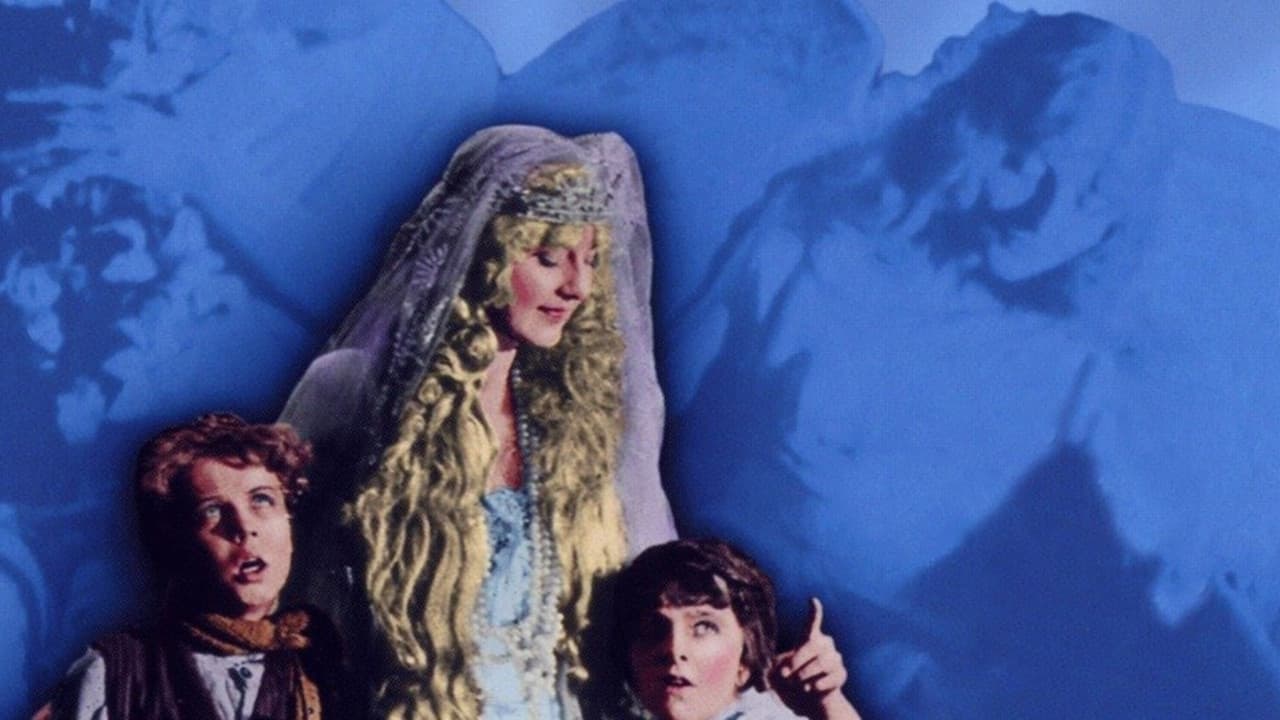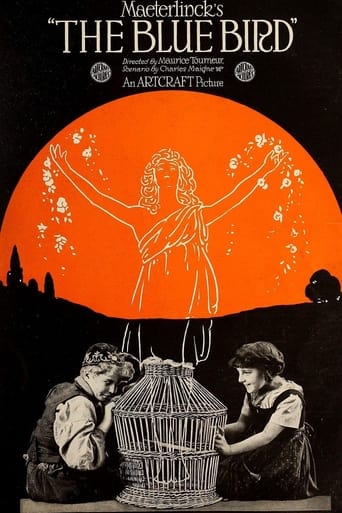

Was this written by a VFX department? Heavy on effects, and light on story, a couple of kids from a poor family have a dream that an angel takes them to heaven and reminds them of all the good stuff in life. To pull this off we get reverse footage, double exposures, stop animation, painted sets, creative editing and so on - all the high tech tricks of the era, which are still being used in cinema today, if a little more convincingly. The feel of the film is part Melies, part 'The Wizard of Oz' (particularly the 1914 version - complete with humans dressed up as animals) and part the dream sequence of Tourneur's earlier 'Poor Little Rich Girl'. Despite some campiness, the visuals are the most interesting thing going for it - there is some nice photography here.But what is the good stuff the angel shows them, you ask? Well, mostly just pretty girls dancing in the outdoors, as it turns out. These images are meant to symbolise ideas, such as 'the joy of pure air'. The 'souls' of inanimate objects like milk and water and light are also symbolised, and guess what they turn out to be - pretty girls! Very cheesy, and completely lacking in the poignancy it tries so hard create, this is only for those who like abstract for the sake of abstract.Now I have no issue with a moral reminding us of the natural virtues of life and the people around us, but a moral alone does not a great film make, and this film is sorely lacking in the most important element - story.
... View MoreBeautiful performances and astonishing special effects highlight this very early allegory of where and how to seek happiness.Other reviewers have commented on the performance of the then very young actress Tula Belle, who was about 12 and who didn't make movies but for two more years, to our loss. No superlatives are excessive.The entire cast was, in fact, excellent, and not a one is well known today. In fact, of the entire production, most of the names are generally unknown today, except for director Maurice Tourneur, film editor Clarence Brown, and -- known to me, at least, because I actually met him in about 1974 -- Ben Carré, who designed both costumes and set. Ben Carré was a genius in his field.For 1918, the special effects were amazing and effective. The entire production was just breath-taking and eye-popping.Seeing this on Turner Classic Movies Sunday night, 17 January 2015 (California time), was an exciting experience, even to me, and I have been a silent movie fan for more than 40 years. I thought I knew the history of the genre, and still have lots to learn.For anyone who missed it on TCM, or for anyone who wants to see it again, it's available at YouTube, three versions at this writing for free and another for a rental fee."The Blue Bird" is a real treat, both for its entertainment value and for its history lesson. The message is perhaps rather corny and maybe not so well delivered in the last shot, but the over-all experience is, to me, just overwhelming. I highly recommend "The Blue Bird."
... View Morewell. can't say this film was totally my cuppatea, but i am neither a true scholar of cinema and i often am put off by how disturbingly strange the overall effect of cinema silents are. i'm not the smartest on the block, but i don't think i'm a total slouch either. i can at least recognize the importance of something because of my partial familiarity with classicism, neo or otherwise. it was pretty obvious of the artistic and cultural importance of Maurice Tourneur's 'Bluebird'.the real problems with this film more than likely have more to do with me. even though i love horror movies and ghost stories, i also scare easily. as a child i had many recurring nightmares that were more often than not, induced by the images i was exposed to at the movies. i admit it. i was one of those silly, wimpy little kids that was frightened by 'OZ' and flying monkeys. even though i love cinema, i can't say for sure if i ever really have gotten used to the whole thing. maybe that's part of the fun. let's hope so.to be perfectly honest i found this movie to be more than just a little bit creepy and disturbing. to be truthful, i thought it was pretty weird. but it was what they say it is. beautiful, mysterious and haunting. unfortunately a little TOO haunting for some of us. it almost feels like having a actual ghost present in the TV room. if i was a kid again watching this, i'd be afraid of it. as a adult i'm not so sure i wasn't afraid of this. fortunately i saw this first as a adult because i could assess the images here better than i would have as a child. after all, don't they always say, "it's only a movie". repeat that thought two more times every time the cinema gets to you too much.not to say that this movie doesn't have moments of charm and humour. once you get used to all that caked on silent movie make up all over those kids faces, they start to look a little more like cute, normal kids. but at first they were kind of off putting. many of the sentiments are well expressed with good insight and tell the folklore with great love of tradition.also the guy that played the cat was a hilarious trip to watch run around on all fours, and the scene where he gets into a fight with the dog is a real guffaw.this also has some of the most beautiful fantasy images from the silent cinema era. a far cry from the often pedestrian imagery in the delightful and cute, but often hokey 'Peter Pan' by Adolph Zukor. love the silent 'Peter Pan', but this is obviously a more sophisticated film-work. and with due respect to James Wong Howe, the cinematography here is more accomplished and stylish. the whole thing was spooky, but definitely otherworldly.it is very sad to note the condition of the film print here. much of it was severely deteriorated and neglected to a shameful extent. this should never happen to any film. that's why film preservation should include all film and television and not be left to personal opinion or pick and choose mentality. one person's garbage is another's personal experience. at least preserving films can tell us something about the time period from which they came and about the persons. no art form should ever go this neglected or abused like this. a testimony to the cruelty man shows against the things he creates in this world.i enjoyed this classic very much. but i can't say children or families of today's commercial driven market will. most kids will probably think it weird and creepy, and their baby boomer and Gen.X parents will be confused by it. this film is probably best enjoyed by cinema scholars or people interested in the classical. whatever, it's probably only people with a learned education that will appreciate this. it's not something you might take to naturally. but who knows, wonders do happen and people can be surprisingly quirky sometimes. it's rare, like this beautiful film, but it happens.a definite must see for silent film fans and scholars in the art of filmmaking. they're probably the ones who can explain this the best.
... View MoreMaurice Maeterlinck's play "The Blue Bird" was produced for the first time in America in October 1910 and was considered a success. If Maurice Tourneur's film productions of both "The Blue Bird" and "Prunella" had met with the success they deserved, they may have paved the way in the twenties for a fantasy film genre instead of the over population of sheiks and flappers!! Most critics were abundant in their praise - "The Moving Picture World" saw in it "the simplicity of childhood and the wisdom of deep and kindly philosophy", Photoplay also praised it as "one of the most important productions ever made" but unfortunately Motion Picture Magazine spoke for the philistine portion of the public when it said "Seven reels of children and trailing through fairy places with bread, water, light and fire is frankly tedious on the screen". The production values were moral and allegorical as well as beautifully pictorial and those of the public that rejected it were all the worse for it.When Mytyl refuses to give her little bird to the sickly child across the way she and brother Tyltyl are visited by a strange old fairy who sends them on a journey of self discovery and to seek the true meaning of happiness. They first meet the spirit of water and fire that their mother had told them about (and they had scoffed at her), their dog and cat then begin to converse with them and tell them all the stories they could only bark and miaow out before.The special effects performed by Ben Carre who was closely associated with Maurice Tourneur, are extraordinary. The children are magically dressed, spilt milk turns into a lovely maid and the fairy of light finally whisks them all to the Fairy Palace, flying high above the roof tops. However Fairy Berylune, who first came to the children has said that whoever finishes the journey with the children shall die - so the cat leads the party who will try to stop the children finding the blue bird. Only the faithful little dog promises to protect them. The Underground Palace of Night - Mother Night has two children, Sleep and Death (probably a bit heavy going for children in the audience) and Mytyl and Tyltyl also find ghosts, sickness, War and terrors behind heavy wooden doors - but no blue birds. They visit the graveyard where the "happy dead sleep" but at a turn of TylTyl's diamond it becomes a beautiful flower land. They finally find the blue bird at their grandparent's little house where they also visit their little brothers and sisters who died in infancy. Unfortunately, when they leave, the blue bird flies away. On to the Palace of Happiness where luxury and riches abound, then there is also the "Happiness of the Home", "Joy of Pure Thoughts" and "Springtime". Another amazing sequence was in the land of children waiting to be born. A ship was waiting to take all the little children to their waiting mother's arms.Enchanting Tula Belle was born in Norway and was just wonderful as Mytyl, a real child if ever there was one. Unlike the two other youngsters in "The Blue Bird" , Robin MacDougall and Katharine Bianchi, she did have a reasonable career as a child actress before retiring in 1920.Highly, Highly Recommended.
... View More